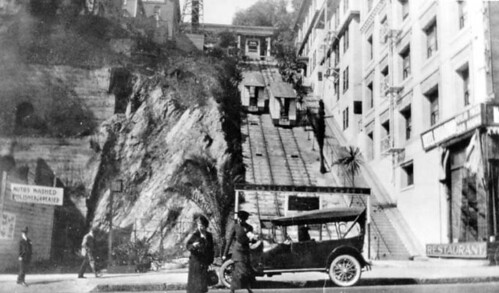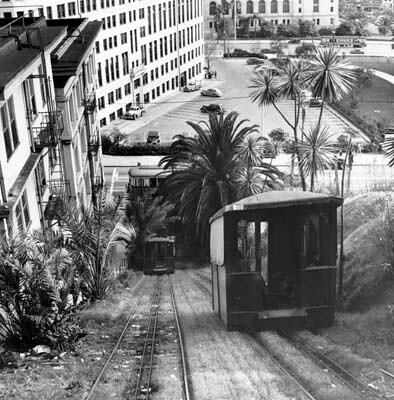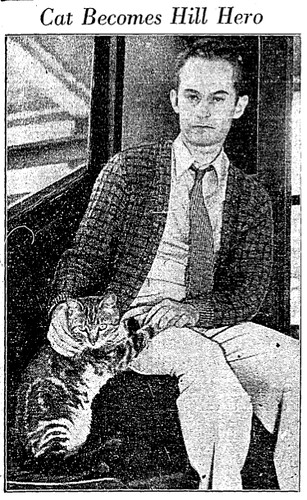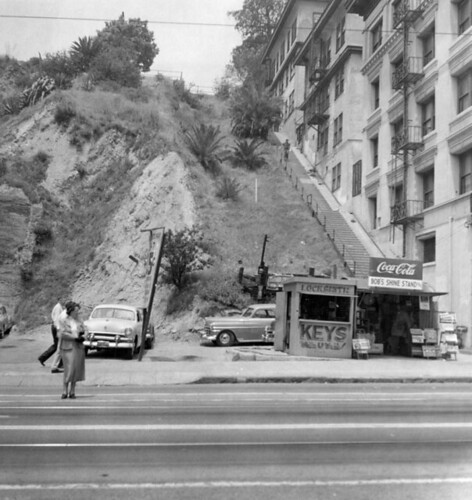
Even the least historically minded Angeleno probably knows about Angels Flight, the beloved funicular that graced the corner of Hill and Third for over 60 years. What many do not realize is that for 40 years, Bunker Hill residents enjoyed two incline railways in their neighborhood. Unlike Angels Flight, which has become one of the defining images of yesterday’s Downtown, Court Flight has become a footnote in the history of the city.
Dreamed up by the Observation Tower Company in 1904, Court Flight was originally envisioned as a tourist spot, more than a practical mode of transportation. The railway was built on portion of Court Street so steep it was passible only to pedestrians by stairs, and its pinnacle was believed to be the highest point Downtown until City Hall was completed in 1928. It was this bird’s eye view of the city that attracted the Observation Tower Company who intended to install a tower at the top of the funicular to make optimum use of the view.

Initial construction began in December 1904 with the grading of the hill and the replacement of the old wooden steps with a concrete staircase. Progress was then halted for months when Mrs. Rachel Hopperstead had an injunction issued claiming that her property at the top of the hill would be damaged by the proposed observation tower. The Company acquiesced, agreeing to forsake the tower. Construction on the incline railway was completed in October of 1905.

Court Flight’s base was located on Broadway and it ran approximately 180 feet up towards Hill Street, in between Temple & First Street. At a 53 percent grade, it was probably the steepest railway in the world (and possibly the shortest as well). The two cars that each carried 14 passengers were designed by a local artisan named Leo Suck and were lavishly furnished with mahogany and large French plate glass mirrors. Unlike Angels Flights, the Court Street cars ran on two separate tracks instead of one. The top of the railway was about 450 feet above sea level and photos from the 1920s reveal that the observation tower was eventually installed and provided visitors with views of Catalina Island. When it opened, a ride cost 5 cents, but books of 100 were available which cost 1 cent per trip. While it was conceived as a way to earn money from the views, Court Flight quickly became popular with Bunker Hill residents traveling to jobs located in the Civic Center and Financial District.


Sam Vandergrift had assumed ownership of the funicular early on and his widow kept it running after his death. By 1942 the railway was operating at a loss despite the steady flow of passengers and the $65 a month in rent from the sandwich shop at its base on Broadway. Additionally, Mrs. Vandergrift was having trouble finding reliable operators who had not enlisted. In January 1943, she was granted a permit to abandon operation, and after 38 years, the cars on Court Flight came to permanent halt. Subsequently, a franchise was granted to an unnamed party to start up operation, which the Board of Public Utilities tried to have terminated. In October of 1943 all issues involving Court Flight were ended when a discarded cigarette ignited the brush around the cable cars. The flames destroyed the tracks in seconds. The cars are rumored to have survived the fire and are supposedly in the possession of a collector in Woodland Hills.

Photos courtesy of the Los Angeles Public Library Photo Collection & USC Digital Archive

